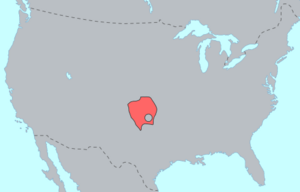Kiowa language facts for kids
Quick facts for kids Kiowa |
||||
|---|---|---|---|---|
| Cáuijògà/Cáuijò:gyà | ||||
| Native to | United States | |||
| Region | western Oklahoma | |||
| Ethnicity | Kiowa people | |||
| Native speakers | 20 (2007) | |||
| Language family |
Tanoan
|
|||
| Linguasphere | 64-CBB-a | |||

Distribution of the Kiowa language after migration to the Southern Plains
|
||||

|
||||
|
||||
Kiowa (also called Cáuijògà or Cáuijò:gyà) is a special language spoken by the Kiowa Tribe of Oklahoma. It is mainly used in parts of Oklahoma, like Caddo, Kiowa, and Comanche counties. The main center for the Kiowa tribe is in Carnegie. Sadly, like many native languages in North America, Kiowa is an endangered language. This means very few people still speak it.
Contents
The Story of the Kiowa Language
The Kiowa language is most closely related to other Tanoan languages, which are spoken by Pueblo groups. However, the Kiowa people themselves lived in western Montana around the year 1700.
Before that, stories passed down through generations, old archaeological finds, and language studies suggest that early Kiowa speakers lived in the northern part of a larger language group. Around 450 AD, they moved north through areas where the Ancestral Puebloans and Great Basin people lived. They settled in the eastern Fremont culture region of the Colorado Plateau until before 1300. Later, they moved further north to the northwestern Plains, arriving in the Yellowstone area by the mid-1500s. This is where Europeans first met the Kiowa people. After that, the Kiowa moved to the Black Hills and then to the southern Plains, where their language was written down in more recent history.
Who Speaks Kiowa Today?
In 1984, an expert named Laurel Watkins said that only about 400 people could speak Kiowa. Most of these speakers were over 50 years old, and very few children were learning the language. Later, in 1999, another expert, Marianne Mithun, reported that about 300 adults could speak Kiowa to some degree. At that time, there were over 12,000 members in the Kiowa tribe.
In 2006, a group working to save native languages in Oklahoma thought there were about 400 fluent Kiowa speakers. By 2013, a newspaper article estimated only 100 fluent speakers were left. UNESCO, a global organization, says Kiowa is 'severely endangered.' They reported that in 2007, only 20 people spoke Kiowa as their first language, and about 80 others spoke it as a second language. Most of these speakers were between 45 and 60 years old.
Helping the Language Grow Again
Many groups are working hard to keep the Kiowa language alive.
- The University of Tulsa, the University of Oklahoma in Norman, and the University of Science and Arts of Oklahoma in Chickasha all offer classes where people can learn Kiowa.
- Kiowa hymns (songs) are sung at the Mount Scott Kiowa United Methodist Church.
- Starting in the 2010s, the Kiowa Tribe began offering weekly language classes at the Jacobson House, an art center for Native Americans in Norman. Dane Poolaw and Carol Williams taught these classes.
- Alecia Gonzales (who was Kiowa/Apache and lived from 1926 to 2011) taught at USAO. She wrote a book to help people learn Kiowa called Thaum khoiye tdoen gyah: beginning Kiowa language.
- Modina Toppah Water (who is Kiowa) helped edit Saynday Kiowa Indian Children’s Stories. This is a book of trickster stories written in the Kiowa language, published in 2013.
- In 2022, Tulsa Public Schools made an agreement with the Kiowa Tribe of Oklahoma to teach Kiowa language and culture in their schools. This is a big step to help more young people learn the language.
How Kiowa Sounds and is Written
Like all languages, Kiowa has its own unique sounds. It has different consonant sounds and vowel sounds. These sounds can be long or short, and some vowels can be nasal (meaning air comes out of your nose when you say them).
A native speaker named Parker McKenzie worked with linguists to create a way to write down the Kiowa language. This writing system helps people learn and preserve the language.
- Vowels are written using letters like a, e, i, o, u.
- Some vowel sounds are written with two letters, like au for a specific sound.
- If a vowel has an i after it (like ai), it means it has a special "y" sound at the end.
- Nasal vowels are shown by underlining the letter, for example, o̲.
- Long vowels have a line over them, like ō.
- Kiowa also uses marks called diacritics to show the tone of a word (how high or low your voice is when you say it). For example, ´ means a high tone, ` means a low tone, and ˆ means a falling tone.
Consonants are written with letters like b, d, g, h, j, l, m, n, s, t, w, y, z. Some sounds use two letters, like ch or th. The writing system is set up in a way that helps people understand how the sounds are made.
See also
 In Spanish: Idioma kiowa para niños
In Spanish: Idioma kiowa para niños

